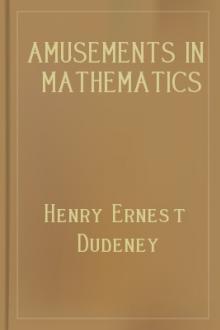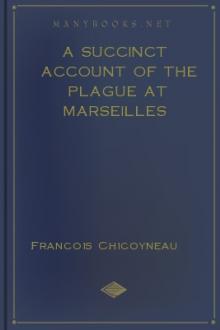Amusements in Mathematics, Henry Ernest Dudeney [books to read to be successful txt] 📗

- Author: Henry Ernest Dudeney
- Performer: 0486204731
Book online «Amusements in Mathematics, Henry Ernest Dudeney [books to read to be successful txt] 📗». Author Henry Ernest Dudeney
It will be seen that no man ever plays with or against his own wife—an ideal arrangement. If the reader wants a hard puzzle, let him try to arrange eight married couples (in four courts on seven days) under exactly similar conditions. It can be done, but I leave the reader in this case the pleasure of seeking the answer and the general solution.
267.—THE WRONG HATS.—solution
The number of different ways in which eight persons, with eight hats, can each take the wrong hat, is 14,833.
Here are the successive solutions for any number of persons from one to eight:—
1 = 0
2 = 1
3 = 2
4 = 9
5 = 44
6 = 265
7 = 1,854
8 = 14,833
To get these numbers, multiply successively by 2, 3, 4, 5, etc. When the multiplier is even, add 1; when odd, deduct 1. Thus, 3 × 1 - 1 = 2, 4 × 2 + 1 = 9; 5 × 9 - 1 = 44; and so on. Or you can multiply the sum of the number of ways for n-1 and n-2 persons by n-1, and so get the solution for n persons. Thus, 4(2 + 9) = 44; 5(9 + 44) = 265; and so on.
268.—THE PEAL OF BELLS.—solution
The bells should be rung as follows:—
I have constructed peals for five and six bells respectively, and a solution is possible for any number of bells under the conditions previously stated.
269.—THREE MEN IN A BOAT.—solution
If there were no conditions whatever, except that the men were all to go out together, in threes, they could row in an immense number of different ways. If the reader wishes to know how many, the number is 4557. And with the condition that no two may ever be together more than once, there are no fewer than 15,567,552,000 different solutions—that is, different ways of arranging the men. With one solution before him, the reader will realize why this must be, for although, as an example, A must go out once with B and once with C, it does not necessarily follow that he must go out with C on the same occasion that he goes with B. He might take any other letter with him on that occasion, though the fact of his taking other than B would have its effect on the arrangement of the other triplets.
Of course only a certain number of all these arrangements are available when we have that other condition of using the smallest possible number of boats. As a matter of fact we need employ only ten different boats. Here is one the arrangements:—
It will be found that no two men ever go out twice together, and that no man ever goes out twice in the same boat.
This is an extension of the well-known problem of the "Fifteen Schoolgirls," by Kirkman. The original conditions were simply that fifteen girls walked out on seven days in triplets without any girl ever walking twice in a triplet with another girl. Attempts at a general solution of this puzzle had exercised the ingenuity of mathematicians since 1850, when the question was first propounded, until recently. In 1908 and the two following years I indicated (see Educational Times Reprints, Vols. XIV., XV., and XVII.) that all our trouble had arisen from a failure to discover that 15 is a special case (too small to enter into the general law for all higher numbers of girls of the form 6n + 3), and showed what that general law is and how the groups should be posed for any number of girls. I gave actual arrangements for numbers that had previously baffled all attempts to manipulate, and the problem may now be considered generally solved. Readers will find an excellent full account of the puzzle in W.W. Rouse Ball's Mathematical Recreations, 5th edition.
270.—THE GLASS BALLS.—solution
There are, in all, sixteen balls to be broken, or sixteen places in the order of breaking. Call the four strings A, B, C, and D—order is here of no importance. The breaking of the balls on A may occupy any 4 out of these 16 places—that is, the combinations of 16 things, taken 4 together, will be
ways for A. In every one of these cases B may occupy any 4 out of the remaining 12 places, making
ways. Thus 1,820 × 495 = 900,900 different placings are open to A and B. But for every one of these cases C may occupy
different places; so that 900,900 × 70 = 63,063,000 different placings are open to A, B, and C. In every one of these cases, D has no choice but to take the four places that remain. Therefore the correct answer is that the balls may be broken in 63,063,000 different ways under the conditions. Readers should compare this problem with No. 345, "The Two Pawns," which they will then know how to solve for cases where there are three, four, or more pawns on the board.
271.—FIFTEEN LETTER PUZZLE.—solution
The following will be found to comply with the conditions of grouping:—
The fifteen letters used are A, E, I, O, U, Y, and B, C, G, L, M, N, P, R, T. The number of words is 27, and these are all shown in the first three columns. The last word, PIU, is a musical term in common use; but although it has crept into some of our dictionaries, it is Italian, meaning "a little; slightly." The remaining twenty-six are good words. Of course a TAU-cross is a T-shaped cross, also called the cross of St. Anthony, and borne on a badge in the Bishop's Palace at Exeter. It is also a name for the toad-fish.
We thus have twenty-six good words and one doubtful, obtained under the required conditions, and I do not think it will be easy to improve on this answer. Of course we are not bound by dictionaries but by common usage. If we went by the dictionary only in a case of this kind, we should find ourselves involved in prefixes, contractions, and such absurdities as I.O.U., which Nuttall actually gives as a word.
272.—THE NINE SCHOOLBOYS.—solution
The boys can walk out as follows:—
Every boy will then have walked by the side of every other boy once and once only.
Dealing with the problem generally, 12n + 9 boys may walk out in triplets under the conditions on 9n + 6 days, where n may be nought or any integer. Every possible pair will occur once. Call the number of boys m. Then every boy will pair m - 1 times, of which (m - 1)/4 times he will be in the middle of a triplet and (m - 1)/2 times on the outside. Thus, if we refer to the solution above, we find that every boy is in the middle twice (making 4 pairs) and four times on the outside (making the remaining 4 pairs of his 8). The reader may now like to try his hand at solving the two next cases of 21 boys on 15 days, and 33 boys on 24 days. It is, perhaps, interesting to note that a school of 489 boys could thus walk out daily in one leap year, but it would take 731 girls (referred to in the solution to No. 269) to perform their particular feat by a daily walk in a year of 365 days.
273.—THE ROUND TABLE.—solution
The history of this problem will be found in The Canterbury Puzzles (No. 90). Since the publication of that book in 1907, so far as I know, nobody has succeeded in solving the case for that unlucky number of persons, 13, seated at a table on 66 occasions. A solution is possible for any number of persons, and I have recorded schedules for every number up to 25 persons inclusive and for 33. But as I know a good many mathematicians are still considering the case of 13, I will not at this stage rob them of the pleasure of solving it by showing the answer. But I will now display the solutions for all the cases up to 12 persons inclusive. Some of these solutions are now published for the first time, and they may afford useful clues to investigators.
The solution for the case of 3 persons seated on 1 occasion needs no remark.
A solution for the case of 4 persons on 3 occasions is as follows:—
Each line represents the order for a sitting, and the person represented by the last number in a line must, of course, be regarded as sitting next to the first person in the same line, when placed at the round table.
The case of 5 persons on 6 occasions may be solved as follows:—
The case for 6 persons on 10 occasions is solved thus:—
It will now no longer be necessary to give the solutions in full, for reasons that I will explain. It will be seen in the examples above that the 1 (and, in the case of 5 persons, also the 2) is repeated down the column. Such





Comments (0)